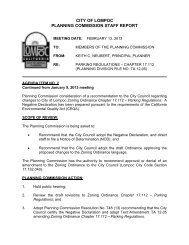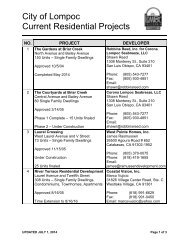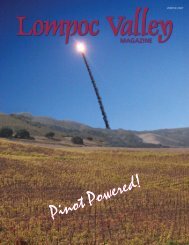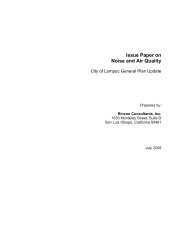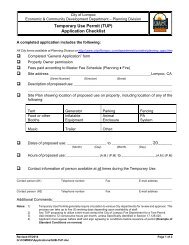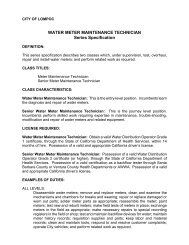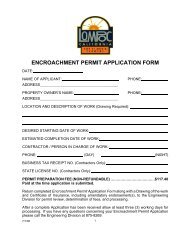Storm Water Pollution Prevention Plan (SWPPP) - the City of Lompoc!
Storm Water Pollution Prevention Plan (SWPPP) - the City of Lompoc!
Storm Water Pollution Prevention Plan (SWPPP) - the City of Lompoc!
You also want an ePaper? Increase the reach of your titles
YUMPU automatically turns print PDFs into web optimized ePapers that Google loves.
OrderG. Determining and Reducing Risk46. The risk <strong>of</strong> accelerated erosion and sedimentation from wind and waterdepends on a number <strong>of</strong> factors, including proximity to receiving waterbodies, climate, topography, and soil type.47. This General Permit requires dischargers to assess <strong>the</strong> risk level <strong>of</strong> asite based on both sediment transport and receiving water risk. ThisGeneral Permit contains requirements for Risk Levels 1, 2 and 3, andLUP Risk Type 1, 2, and 3 (Attachment A). Risk levels are establishedby determining two factors: first, calculating <strong>the</strong> site's sediment risk;and second, receiving water risk during periods <strong>of</strong> soil exposure (i.e.grading and site stabilization). Both factors are used to determine <strong>the</strong>site-specific Risk Level(s). LUPs can be determined to be Type 1based on <strong>the</strong> flowchart in Attachment A.1.48. Although this General Permit does not mandate specific setbackdistances, dischargers are encouraged to set back <strong>the</strong>ir constructionactivities from streams and wetlands whenever feasible to reduce <strong>the</strong>risk <strong>of</strong> impacting water quality (e.g., natural stream stability and habitatfunction). Because <strong>the</strong>re is a reduced risk to receiving waters whensetbacks are used, this General Permit gives credit to setbacks in <strong>the</strong>risk determination and post-construction storm water performancestandards. The risk calculation and run<strong>of</strong>f reduction mechanisms inthis General Permit are expected to facilitate compliance with anyRegional <strong>Water</strong> Board and local agency setback requirements, and toencourage voluntary setbacks wherever practicable.49. Rain events can occur at any time <strong>of</strong> <strong>the</strong> year in California. Therefore,a Rain Event Action <strong>Plan</strong> (REAP) is necessary for Risk Level 2 and 3traditional construction projects (LUPs exempt) to ensure that activeconstruction sites have adequate erosion and sediment controlsimplemented prior to <strong>the</strong> onset <strong>of</strong> a storm event, even if construction isplanned only during <strong>the</strong> dry season.50. Soil particles smaller than 0.02 millimeters (mm) (i.e., finer thanmedium silt) do not settle easily using conventional measures forsediment control (i.e., sediment basins). Given <strong>the</strong>ir long settling time,dislodging <strong>the</strong>se soils results in a significant risk that fine particles willbe released into surface waters and cause unacceptable downstreamimpacts. If operated correctly, an Active Treatment System (ATS 5 ) canprevent or reduce <strong>the</strong> release <strong>of</strong> fine particles from construction sites.5 An ATS is a treatment system that employs chemical coagulation, chemical flocculation, or electrocoagulation in order to reduce turbidity caused by fine suspended sediment.2009-0009-DWQ 8 September 02, 2009



